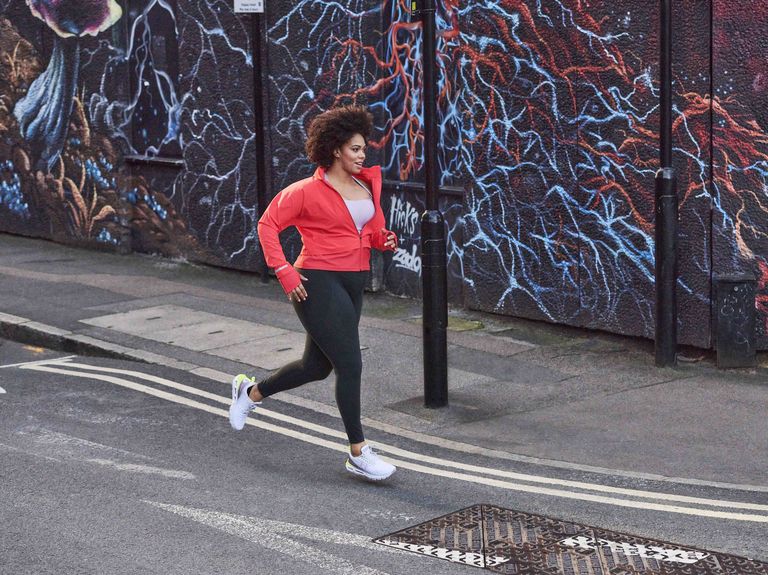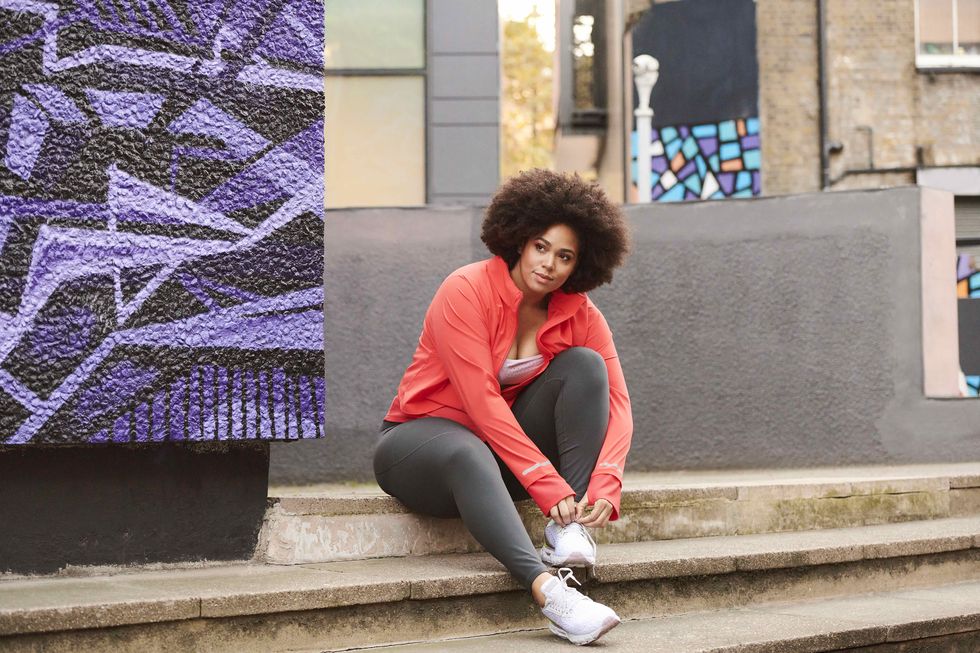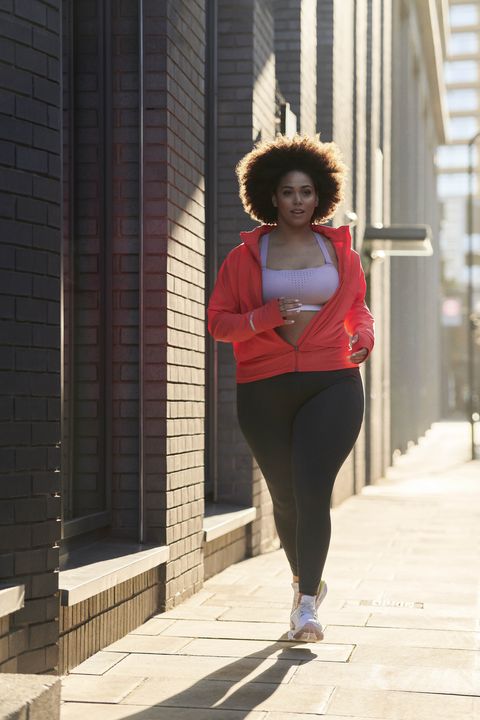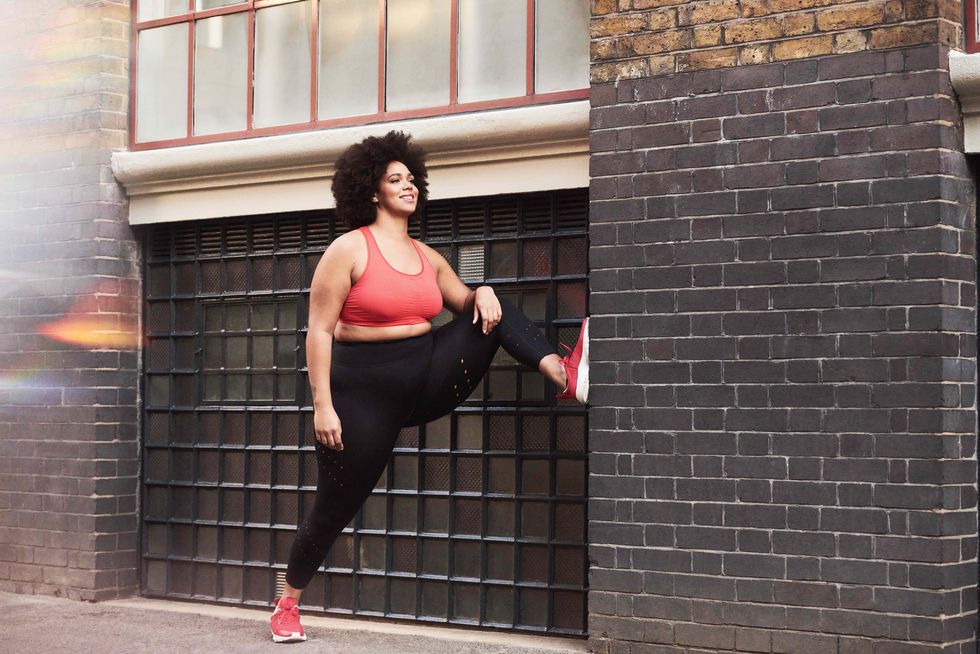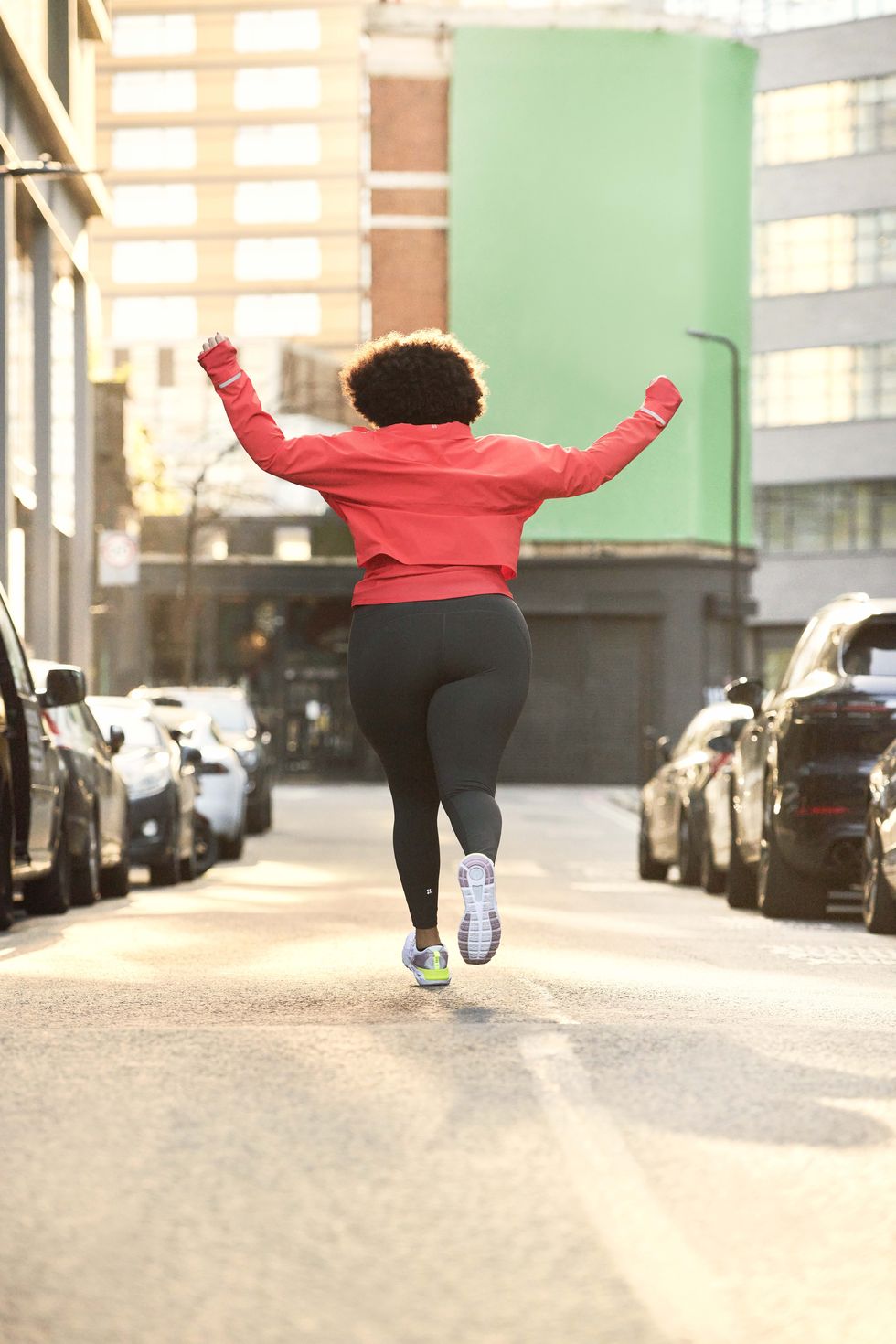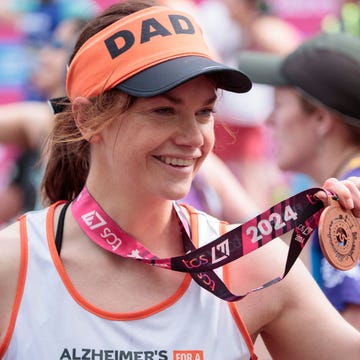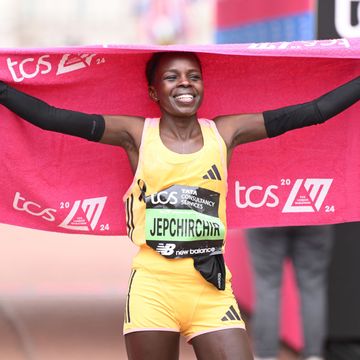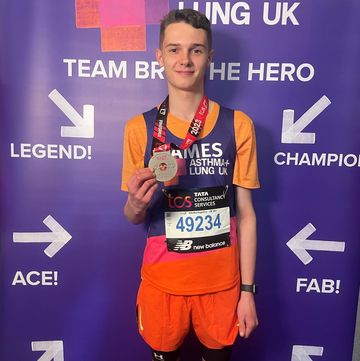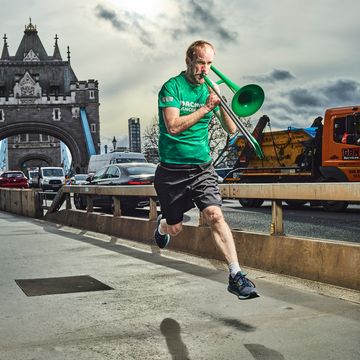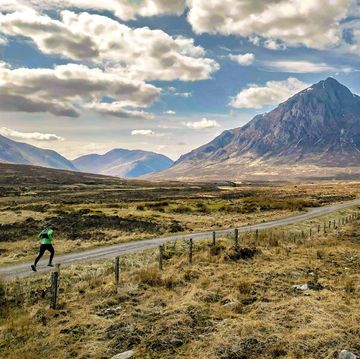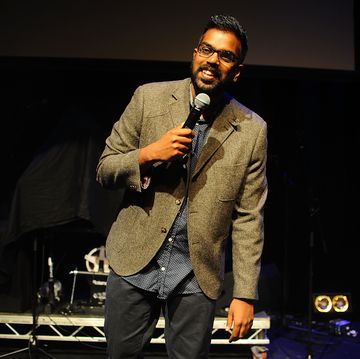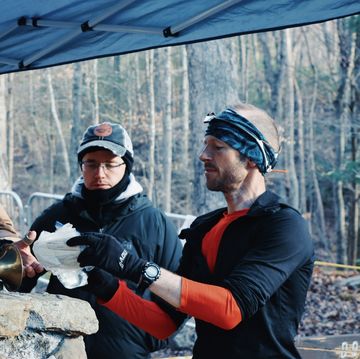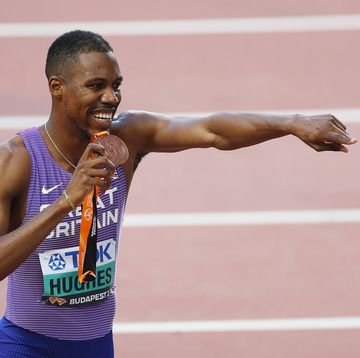As well as being a passionate and eloquent campaigner for body-positivity, Shareefa J is herself a powerful illustration of why we need to challenge our perceptions of what a healthy body looks like. A few years back, she was a size 8 and a closer match to the accepted, aspirational fit and healthy aesthetic. She was also unwell and emotionally unstable. Now she’s healthy, happy and running 10Ks in her underwear. And yes, she’s bigger, too.
We caught up with her to hear how she thinks it’s high time we focussed more on what our bodies can do than what they look like, that we look beyond the ingrained fat phobia in our culture to a truer and broader image of health, and we debunk the myth that running is just for one type of person.
Runner’s World It’s great to have you on the cover of the February issue. Do you think the media and running industry can help more people to get involved in the sport by celebrating a broader range of body types?
Shareefa J ‘Definitely. For people to want to – and feel that they can – get involved in this community then the representations that they see just have to be a bit more tangible. It just feels so unattainable for so many people. They feel too intimidated to even put on a pair of pair of trainers and go out running because they are so worried that they don’t look like the “typical runner”, and so would feel too embarrassed.’
I get a lot of questions on my instagram from people asking, “How do you have the confidence to go running in your local area”. And it makes me really sad that people have been made to feel that way because I think we spend so much time focussing on the aesthetic of health and fitness but forgetting that it’s actually incredible for your mental health, it’s amazing for your hormones, it’s amazing for your posture and just to keep your body healthy all round. Everyone thinks about fitness as a way to achieve a certain body type, or to lose weight, or to gain abs… whereas I think about fitness as great way to keep my mind healthy, to keep my body healthy, to keep my joints healthy and I just think that conversation is not being had enough.’
RW Do recent examples of backlash against pictures that don’t fit the traditional fitness aesthetic show how rooted body image is into our concept of health and fitness?
SJ ‘There’s a lot of fat phobia. I think that people aren’t necessarily willing to admit that they have this ingrained fat phobia from our culture. I don’t want to get too political here, but if you turn on the television you’re bombarded with statements about what it means to be overweight and how it’s so bad for your health, but there’s a lack of balance because people don’t talk so much about the negative impact of gym addiction, or eating disorders, or people who have an obsession with weighing their food. No one really talks about that as being as much of a problem – in fact it’s even encouraged in society with apps like myfitnespal and these ripped bodies on the covers of magazines to encourage that in the fitness world.’
RW So it’s important to look beyond how a body looks?
SJ ‘There’s an amazing content creator who makes Instagram videos and he has an 8-pack, but he always points out that even though he has the 8-pack he has problems with his joints and he has Crohn’s disease and all these different issues which you wouldn’t expect from looking at this “perfect”, aspirational body. And I think that opens a really interesting conversation when it comes to fat phobia and being fat being seen as being so unhealthy. But what is health? Define health. Because someone might have a slightly higher body mass index, but it doesn’t necessarily mean they are less healthy. I used to have a much lower BMI. Four or five years ago I was a size 8 and I used to eat an apple a day and a piece of salmon occasionally, and I had an eating disorder and I was unwell and emotionally unstable. My nails wouldn’t grow, my hair wouldn’t grow and I had stomach ache constantly. So yes, I was thin, my body was thin and probably more acceptable but did it mean it was healthier? I would definitely say no because right now my body mass index is higher but my mind is healthier, my skin is healthier, my hair grows… I feel healthy even though I am just, you know, a little bit fatter.’
RW Do we need to broaden our definition of what a healthy body looks like?
SJ ‘Absolutely, and I’m so glad to see some fitness brands embracing that. I’ve been modelling around the world for eight years now and this last couple of years has seen by far the most fitness-based ad collaborations and partnerships I’ve had. I just never would have been considered in this space two or three years ago and now brands are finally starting to realise that actually people want to see this. It’s incredible and I think it’s really important. Brands aren’t the be all and end all of course, but they are very integrated in the running and fitness community, so it’s significant to see brands now starting to use plus size women or different body shapes as an aspirational fitness look.’
RW What role has your running played for you personally in these strange times we’ve all be living through?
SJ ‘It’s obviously been a really difficult, turbulent – unprecedented I think is the word of the times isn’t it? – period and the main thing that running has always done for me is that it’s kept me on track with my goal-setting. When I know that I’ve got a challenge coming up – even if it’s a virtual race – knowing that I have that goal gets me out of bed. It gets me up and out of the house and doing something because I know that in six weeks or 10 weeks or whatever, I have to run that race. So for me running has been a huge saviour. Midway through that first lockdown I’d lost a lot of my jobs, a lot of my contracts had been put on hold and I was just feeling quite aimless. I think a lot of people were in the same boat and running was one of the only things that I could control. Running was like a little sanctuary wasn’t it? A little safe space. So I made myself a fitness plan and I stuck to it and that really helped to keep me grounded. And also knowing that I had those goals forced me up and out of the house for my one hour of exercise. It really was a saving grace and in turn, obviously, keeping it up helped me to feel mentally stronger.’
RW You ran the Vitality London 10K with a group of friends, all wearing only your underwear. What message were you communicating then and what’s the outfit plan for your next race?
SJ ‘At the moment the attire is up for debate, mainly because it’s quite cold! I think we ran that race in May and it was really nice and warm. We ran past the queen’s house in our underwear, sweating and having a great time. I think I got a tan actually!
The message was just about being positive about your body, whatever state it’s in. We place so much emphasis on what our bodies look like, but if you actually step outside of that for a second you remember that your body is this incredible vessel. You put stuff into them and they turn it into energy and they do all this other stuff you ask of them, and you’re breathing the whole time and your brain is working. Our bodies are just incredible machines so I always find it amazing that the only thing that anyone ever focusses on is the size of their bum! For me the message is about celebrating this incredible body that we’ve been given.
You should also remember that your body changes throughout your whole life – from when you’re a baby to an old man or woman warm in your bed your body is going to be completely different. So I think it’s important that no matter what state your body is in at a particular moment – maybe you had a good Christmas and perhaps you ate a few too many pies, or you’ve been stressed and perhaps you haven’t been eating as much as you should – to say this is me, this is how I look right now and that’s okay. There’s nothing worse than punishing yourself. Your body reacts to the environment and it reacts to stress. Sometimes you gain weight as a protection mechanism or you eat more because there is something emotional going on, so rather than punishing yourself for the changes, love what you see in the mirror right now. You can also then set your goals to work on what you feel you need to, but throughout that period self-punishment is so detrimental and it’s so sad to see people doing. Instead try to celebrate you, to love what you’ve got and what you’ve been given and work with it.’
RW Is the key to accept yourself as you are at any particular moment?
SJ ‘When it comes to your body what other message could there really be other than you have to just own what you’ve got? Because unfortunately – or fortunately – it’s not going to change. You can do things to change your body in certain ways but ultimately this is what you’ve been given. At the extremes of this desire for change I do feel quite passionately about young men and women who feel like they need to get lots of plastic surgery to find happiness within themselves. Although I support anyone’s decision to do what makes them feel happy, I do wonder where we got this attitude from. If you were an alien and you came down from space and saw people doing this you would think, “What on earth is going on here?”. Rather than doing all this to change yourself, embrace what you’ve got and love it.’
RW Unfortunately so many people struggle with finding that kind of positivity and with their mental health in general. What advice do you have for them?
SJ ‘I would say I’m a pro at this and the reason why I’m a pro is that I do have quite a long history of mental health issues: I suffered quite badly with anxiety and depression over the years and I had ADHD, which is a neurological disorder not a mental health problem, but it definitely affects me in my day-to-day. Because of all this I’ve had to go out and find the tools to help myself manage over the years.
Sleep is so important, so a big thing for me is to make sure you’re getting enough sleep by practicing good sleep hygiene, which I think a lot of people, especially now with social media, don’t do. People climb into their beds at 11 or 12 o’clock and they’re still on Instagram or scrolling through their emails or their WhatsApp and looking at that screen constantly. Good sleep hygiene means switching your phone off, or putting your phone in a drawer or onto aeroplane mode at 8pm. People always say, “But I don’t have an a alarm clock”. Well, buy an alarm clock. It’ll cost you £2.50, and then have a good, proper rest before bed. Relax, read a book or have a bath and make sure that you are able to switch your brain off to have a full rest because if you don’t have a full rest you just wake up the next day and you feel like, you know… shit.
Also, it’s a bit of a no-brainer, but healthy eating and exercise are just so key when it comes to your mental function that it’s really important to keep on top of that, too. If things slip, don’t punish yourself, but try to set yourself goals to keep on top of your exercise and your eating.’
RW And what if you’re still struggling with your mental health despite taking those steps?
SJ ‘Of course, staying in touch with your support network is also important – reaching out to people when you’re feeling like you’re having a difficult time. I’m an ambassador for the mental health charity CALM, which stands for the Campaign Against Living Miserably, and I think a lot of people do unfortunately live miserably and some of that is to do with the fact that people just don’t feel that they can talk to anyone. They don’t feel that they can open up and have these conversations, but the power of vulnerability, the power of allowing yourself to reach out to that closest person and say, “I’m having a difficult time”… you will be surprised at how powerful that can be.’
If you’re really struggling I would always recommend to just go and see your GP. There’s still so much stigma around mental health that a lot of people just don’t feel like they can, but if you don’t feel like things are manageable go and see your GP and they will always be able to signpost you to the people who will give you the support that you need. And of course you can always contact CALM. They have an amazing service, 365 days a year.
Keeping on top of it and checking in with yourself is important, too. Just saying to yourself, “Am I okay?”. Perhaps you might react badly to something – you might, say, have a really dramatic response to a work email and think, ‘Why did I react like that? It can make you realise that actually you’re feeling low, and then rather than just ignoring it and moving forward, actually dealing with how you’re feeling in the moment, doing that little bit of introspection is really important for us. So checkin with yourself, sleep, eat, exercise, reach out to your support network, and if you’re really struggling contact your GP or CAPM.’
RW Going back to the issue of body image… what message do you have for people who think they don’t have the physique to be runners?
SJ ‘It’s such a myth. It’s such a crazy myth that running is for just one type of person. I can completely understand why people would feel like that before they get involved in the running community but when you go to a race or a parkrun start line you see all these different body shapes. When I ran my first half marathon I was amazed at all these different body shapes – there were really tall people, shorter people, there were bigger people and all different races and it was just incredible.
What I would always say to people starting out though is the thing about running is that you have to build it up over time. No one is going to go from couch to 5K in one run, so take it at your own pace. We’ve all done it, we’ve got ourselves all psyched up for the run, got our playlist ready, got all our new gear on and then the first two or three minutes you’re off like Sonic the Hedgehog, running as fast as you can and then you realise that, "Oh my god, I’m absolutely exhausted. That was awful. I’m going to be sick. I’m never going on a run again. This was the worst thing ever.” So when you are starting out, take it at your own pace and just do what you can. But whatever you can do, you have to let go of this idea of what a runner looks like. If you want to run, you are a runner. If you choose today to go running that makes you a runner.’
